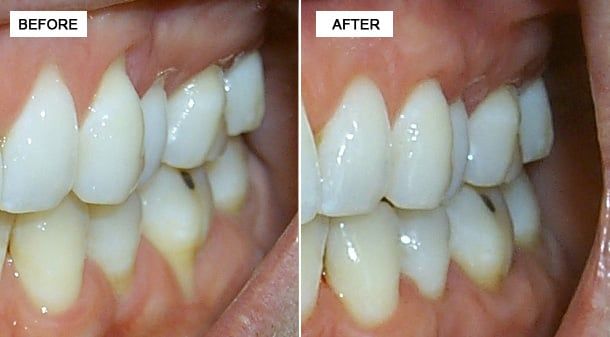Periodontics
A periodontist specializes in the prevention, diagnosis, and treatment of periodontal disease, also known as gum disease. They are trained to perform a variety of procedures that can maintain and improve the health of the soft tissues in your mouth.
Make AppointmentLaser Pocket Disinfection (LPD)
- Kills bacteria and disrupts biofilm to reduce inflammation
- No shots needed
- Maintain healthy gums and avoid progression of gum disease
- No antibiotics needed, avoids antibiotic resistance
- The laser light can reach and destroy bacteria up to 6mm beyond the surface to help prevent bacteria from spreading back into the pocket
- Safe for medically compromised patients, those on blood thinners, or those with diabetes

Crown Lengthening
Crown lengthening is a surgical procedure that re-contours the gum tissue and often the underlying bone of a tooth. Crown lengthening is often for a tooth to be fitted with a crown. It provides necessary space between the supporting bone and crown, which prevents the new crown from damaging bone and gum tissue.
Bone Regeneration
When a tooth is lost, both bone and gum tissue compete for the vacant space. The gum tissue generates more quickly than bone, subsequently occupying the space. With a membrane placement we can keep the gum tissue from invading the space, which will ideally give the bone sufficient time to regenerate. Bone regeneration is often used to rebuild the supporting structures around the teeth, which have been destroyed by periodontal disease. Bone surgery may be used to attempt to rebuild or reshape bone. Grafts of the patient's bone or artificial bone may be used, as well as special membranes.
Socket Regeneration
When a tooth is extracted and an implant is to be placed (either simultaneously or in the future) it is always necessary to complete bone grafting within the residual sockets that are left behind after the roots of the tooth are removed. The shape of the tooth root is always different from the shape of a dental implant and hence there are always residual socket defects (holes) that must be filled in so that there can be excellent contact of the implant to the newly formed bone.
Sinus Lift
The human skull has several cavities or air spaces called sinuses. When the sinus is enlarged and intrudes on areas where we want to place dental implants, bone or bone growth stimulation material is placed into the sinus. This procedure only affects the maxillary sinuses, which are located just over the molar teeth in the upper jaw. The side of the maxillary sinus is opened and the bottom is raised so it will fill in with bone. Several months later, dental implants can be placed in solid bone.
An "Osteotome Lift" is a surgical procedure that raises the floor of the sinus directly over where the implant is placed. This can be done without actually opening the sinus.
Soft Tissue Grafting
Root exposure resulting from gingival tissue recession may pose multiple problems for patients:
- Undesirable Aesthetics
- Root Sensitivity
- Impaired Oral Hygiene
- Increased Caries Susceptibility
- Teeth May Become Loose
A gingival tissue graft will restore the proper gum tissue structure around the tooth.

Gum Lift
A gum lift may be performed to create a more even gum line. Patients with a gummy smile can quickly and safely have unwanted tissue removed, thus exposing more tooth to shape a more attractive smile.
Gum Flap Surgery
When deep pockets between teeth and gums (6 millimeters or deeper) are present, it is difficult for a dentist to thoroughly remove the plaque and tartar. Gum flap surgery is a procedure where the gum flap is lifted away from the tooth. Diseased tissue and sometimes bone is removed. The rough surfaces of the tooth are then smoothed by root planing. The area is medicated and the gum flap is replaced and sutured allowing the bone and gum tissue to heal.
One of the goals of gum flap surgery is to reduce the depth of the periodontal pockets to make them easier to keep clean.
Frenectomy
If a patient has an excess amount of tissue that connects the lower and upper lips to the jaw and gum line, a frenectomy procedure is performed to remove the excess tissue. A frenectomy is either performed inside the middle of the upper lip, which is called a labial frenectomy, or under the tongue, called a lingual frenectomy. Frenectomy is a very common dental procedure in the dental world and is performed both on children and adults.
Ridge Regeneration
When a tooth is lost and not immediately replaced, the bone reacts to this event by 'shrinking back'. The bone becomes thinner from a width perspective and the bone height is frequently reduced. This process is known as bone resorption. In order to place implants, it is necessary to rebuild the bone width and height through regenerative surgical therapy. Bone grafting of the ridge is almost always required to enable accurate placement of dental implants. The grafting is completed utilizing tissue bank and/or synthetic bone particles combined with collagen membranes. It is a highly predictable procedure.